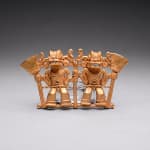Chiriqui Gold Pendant of Two Deities, 11th Century CE - 16th Century CE
Gold
height 7 cm
height 2 3/4 in
height 2 3/4 in
FJ.5086
In Panama, metallurgy was introduced from the south during the first five hundred years of the Christian era. It was quickly adapted to the myths, legends and symbols of the...
In Panama, metallurgy was introduced from the south during the first five hundred years of the Christian era. It was quickly adapted to the myths, legends and symbols of the local population, resulting in magnificent works of art, brilliant in their technology and artistic expression. These objects rapidly became the primary symbols of authority in Isthmian society. Gold not only bedecked the bodies of important people in life but also accompanied them in death. This striking pendant in the form of a twinned bat/reptile figure most surely adorned the body of a very important warrior. Fierce animal characteristics such as those depicted on these twin figures were often used to draw attention to the aggressive or warlike attributes of the wearer and also functioned as the signature of individual warriors. The choice of bat and reptile characteristics, seen here in the mask's erect bat-like ears and the crocodile-like long snout and pointed teeth is typical in Panamanian art. Reptiles were revered as extremely fierce animals while bats exemplified contrasts, symbolizing the upper world by their ability to fly and the nether world by their nocturnal life. Another symbol of the all important warrior class appears on the pendant in the form of two paddles, one held by each figure; these are wooden macanas, or clubs, used by the warriors in battle. Yet another authoritative symbol is the twisted cord belt that runs along the waist of each figure, representing high-status "Golden Clothing." An animal headed spear held by each warrior figure adds another attribute of power to the figures as well as adding to the overall compositional balance of the pendant. All in all, this sensational work of Panamanian artistry speaks of a society extremely skilled in metallurgy and highly sensitive to the world of nature, its primal force and beauty.
Literature
V8



